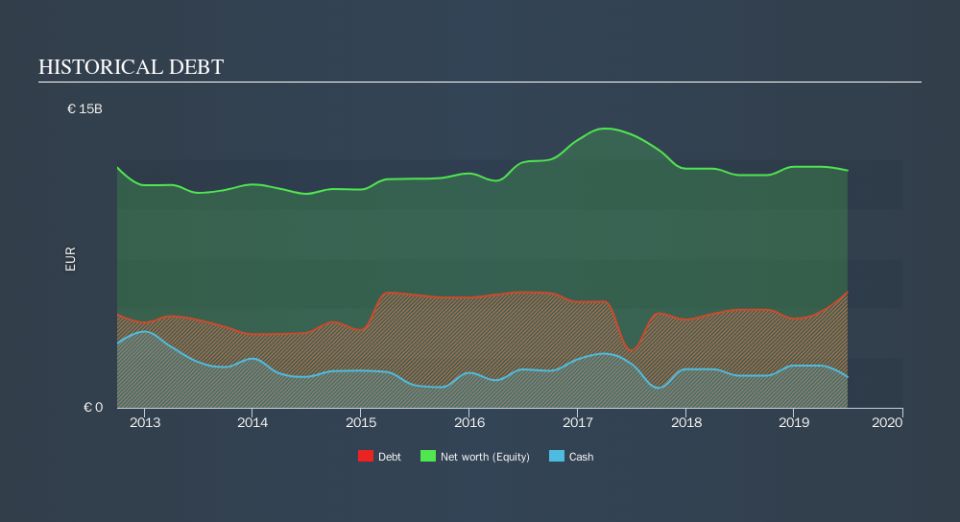Is Koninklijke Philips (AMS:PHIA) Using Too Much Debt?

Warren Buffett famously said, 'Volatility is far from synonymous with risk.' So it might be obvious that you need to consider debt, when you think about how risky any given stock is, because too much debt can sink a company. Importantly, Koninklijke Philips N.V. (AMS:PHIA) does carry debt. But the real question is whether this debt is making the company risky.
What Risk Does Debt Bring?
Debt and other liabilities become risky for a business when it cannot easily fulfill those obligations, either with free cash flow or by raising capital at an attractive price. If things get really bad, the lenders can take control of the business. However, a more frequent (but still costly) occurrence is where a company must issue shares at bargain-basement prices, permanently diluting shareholders, just to shore up its balance sheet. By replacing dilution, though, debt can be an extremely good tool for businesses that need capital to invest in growth at high rates of return. When we think about a company's use of debt, we first look at cash and debt together.
See our latest analysis for Koninklijke Philips
What Is Koninklijke Philips's Debt?
As you can see below, at the end of June 2019, Koninklijke Philips had €5.49b of debt, up from €4.93b a year ago. Click the image for more detail. However, it also had €1.55b in cash, and so its net debt is €3.94b.
A Look At Koninklijke Philips's Liabilities
Zooming in on the latest balance sheet data, we can see that Koninklijke Philips had liabilities of €7.13b due within 12 months and liabilities of €7.29b due beyond that. Offsetting these obligations, it had cash of €1.55b as well as receivables valued at €3.97b due within 12 months. So its liabilities outweigh the sum of its cash and (near-term) receivables by €8.90b.
Koninklijke Philips has a very large market capitalization of €39.2b, so it could very likely raise cash to ameliorate its balance sheet, if the need arose. However, it is still worthwhile taking a close look at its ability to pay off debt.
In order to size up a company's debt relative to its earnings, we calculate its net debt divided by its earnings before interest, tax, depreciation, and amortization (EBITDA) and its earnings before interest and tax (EBIT) divided by its interest expense (its interest cover). This way, we consider both the absolute quantum of the debt, as well as the interest rates paid on it.
Koninklijke Philips's net debt is only 1.5 times its EBITDA. And its EBIT easily covers its interest expense, being 25.8 times the size. So we're pretty relaxed about its super-conservative use of debt. If Koninklijke Philips can keep growing EBIT at last year's rate of 13% over the last year, then it will find its debt load easier to manage. When analysing debt levels, the balance sheet is the obvious place to start. But it is future earnings, more than anything, that will determine Koninklijke Philips's ability to maintain a healthy balance sheet going forward. So if you want to see what the professionals think, you might find this free report on analyst profit forecasts to be interesting.
Finally, while the tax-man may adore accounting profits, lenders only accept cold hard cash. So we always check how much of that EBIT is translated into free cash flow. During the last three years, Koninklijke Philips generated free cash flow amounting to a very robust 88% of its EBIT, more than we'd expect. That puts it in a very strong position to pay down debt.
Our View
Koninklijke Philips's interest cover suggests it can handle its debt as easily as Cristiano Ronaldo could score a goal against an under 14's goalkeeper. And that's just the beginning of the good news since its conversion of EBIT to free cash flow is also very heartening. It's also worth noting that Koninklijke Philips is in the Medical Equipment industry, which is often considered to be quite defensive. Looking at the bigger picture, we think Koninklijke Philips's use of debt seems quite reasonable and we're not concerned about it. After all, sensible leverage can boost returns on equity. Over time, share prices tend to follow earnings per share, so if you're interested in Koninklijke Philips, you may well want to click here to check an interactive graph of its earnings per share history.
At the end of the day, it's often better to focus on companies that are free from net debt. You can access our special list of such companies (all with a track record of profit growth). It's free.
We aim to bring you long-term focused research analysis driven by fundamental data. Note that our analysis may not factor in the latest price-sensitive company announcements or qualitative material.
If you spot an error that warrants correction, please contact the editor at editorial-team@simplywallst.com. This article by Simply Wall St is general in nature. It does not constitute a recommendation to buy or sell any stock, and does not take account of your objectives, or your financial situation. Simply Wall St has no position in the stocks mentioned. Thank you for reading.

